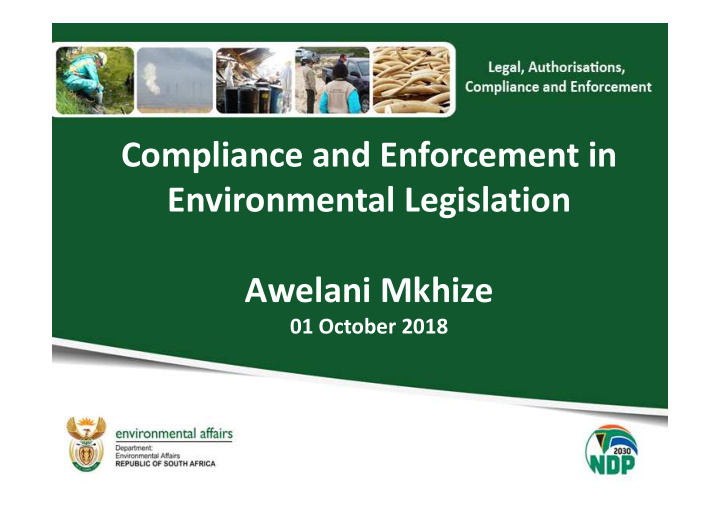



Compliance and Enforcement in Environmental Legislation Awelani Mkhize 01 October 2018
Empowering Legislations Constitution of the Republic of South Africa 1996 Constitution: Sec 24 “Everyone has the right to have the environment protected, for the benefit of • present and future generations, through reasonable legislative and other measures…” Framework Legislation: National Environmental Management Act 107 of 1998 • Criminal Procedure Act 51 of 1977 ( Chapter 2,5,7 and 8) • SEMA’S: Specific Environmental Management Acts: National Environmental Management Protected Areas Act 57 of 2003 • National Environmental Management Biodiversity Act 10 of 2004 • NEM:WA, NEM:ICMA and NEM:AQA • Regulations: Convention on International Trade in Endangered Species Regulations (CITES) • Threatened or Protected Species Regulations (TOPS) • Alien And Invasive Species Regulations (AIS) • Provincial Ordinance’s
MAIN PRESSURES MAIN PRESSURES Habitat loss & degradation • Invasive alien species • Illegal wildlife trade • The unsustainable use / overexploitation of resources • Climate change • Desertification, land degradation and drought • Pollution •
SCALE SCALE Fauna: $7 Fauna: $7 - $23 billion $23 billion annual annually ly Flora: $30 - Flora: $30 $100 billion $100 billion THREAT THREAT annually annual ly SUSTAINABLE SUSTAI NABLE FINANCE? FINANCE? DEVELOPMENT DEVELOPM ENT WILDLIFE WILDLIFE CRIME CRIME SUCCESSES SUCCESSES SIGNIFICANT SIGNIFICANT & THREAT THREAT PROGRESS PROGRESS WILDLIFE WILDLIFE RESPONSES RESPONSES TRAFFICKING TRAFFICKING
CITES: Convention on International Trade in Endangered Species of Wild Fauna and Flora
The purpose of CITES is to ensure that wild fauna and flora in international trade are not • exploited unsustainably CITES is an international convention that combines wildlife and trade themes with a legally • binding instrument for achieving conservation and sustainable use objectives This framework and common procedural mechanism are now used by 183 countries to • regulate and monitor international trade in listed species CITES was signed on 3 March 1973, and entered into force on 1 July 1975. • CITES has been in operation for over 40 years
CITES Appendices Appendix I: Species threatened with extinction, which are or may be affected by trade Pangolin Cycad Elephant Ivory Black Rhino Leopard Appendix II: Species not necessarily threatened with extinction, but for which trade must be controlled to avoid their becoming so, and species that resemble species already included in Appendix II Lion Aloe Chameleon Seahorse Vulture Appendix III: Species for which a country is asking Parties to help with its protection Kalafong Beetle
Restricted Activities Picking / Gathering Capturing Hunting Exporting Importing Conveying Growing
Acacia mearnsii Black Wattle Solanum mauritianum Bug Weed Alien and Invasive Species Regulations Antilope cervicapra Indian Blackbuck Dama dama Fallow Deer
Categories of Listed Invasive Species Category 1a Listed Invasive Species (Kangaroo thorn, Carolina) Take immediate steps to combat or eradicate listed invasive species. Category 1b Listed Invasive Species (Jacaranda, Morning Glory, most wattles) Control the listed invasive species. Comply with any Invasive Species Management Programme. Category 2 Listed Invasive Species Require a Permit to carry out a restricted activity within specified area. Must ensure that the specimens of the species do not spread outside of the land or the area specified in the Notice or Permit. Specimens that occur outside the Permitted area or conditions are then Category 1b species. Category 3 Listed Invasive Species Subject to exemptions and prohibitions, as specified in the Notice. Any Category 3 plant specimen in riparian areas is to be a Category 1b species. Comply with any Invasive Species Management Programme.
Alien Species (1) A Person may not carry out a restricted activity involving a specimen of an alien species without a permit issued in terms of Chapter 7. (2) A permit referred to in subsection (1) may be issued only after a prescribed assessment of risks and potential impacts on biodiversity is carried out. Tiger Turkey Gooty’s Caiman
Invasive Species TRANSPORTING Possession Breeding Importing
Common Species and Smuggling Techniques The aim is not to know everything, but to identify that which is suspicious…
Hippo Ivory Ivory Elephant Ivory
Ivory
Ivory Schreger Lines
Rhino & Rhino Horns White or Black? Actually neither?
Rhino Horn Field Test Light Test: Burn / Smell Test: 3 easy steps: Drop Test:
Pangolin
Pangolin Trade
Pangolin Trade
Reptile Trade Bitis schneideri Namaqua Dwarf Adder Cordylus giganteus Oufolk
Bird Trade
Cycad Trade
Muti Trade
Smuggling Using Vehicles
Smuggling on Person
Smuggling with Pack Animals Animals can be used to smuggle goods over the border. Pay attention not to only search the smuggler but also the donkeys
Penalties • (1) A person convicted of an offence in terms of section 101 is liable to a fine not exceeding R10 million, or an imprisonment for a period not exceeding ten years, or to both such a fine and such imprisonment Charges Possession of TOPS Species = Section 57(1) of NEMBA • Import or Export of CITES Species = Section 57(1A) of NEMBA • Possession or Transport of AIS Species = Section 71 of NEMBA •
Questions? Awelani Mkhize : +27 11 3903687/ 011 3902311 083 683 4297 amkhize@environment.gov.za
Recommend
More recommend